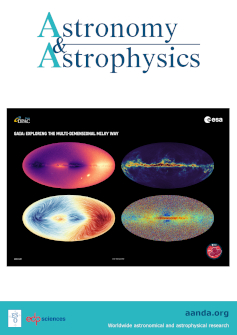地狱中的气候变化蒸发行星K2-22b凌日的长期变化
IF 5.4
2区 物理与天体物理
Q1 ASTRONOMY & ASTROPHYSICS
引用次数: 0
摘要
背景。超短周期轨道上的岩石行星可能有表面岩浆海洋和岩石-蒸汽大气,尘埃可以在其中凝结。对这些尘埃的观测可以让我们了解这些天体的成分和表面状况。我们对蒸发行星K2-22b的凌日尘埃云的性质和长期(十年)行为进行了约束。方法:我们利用MuSCAT地面多光通道成像仪对K2-22b进行了40次左右的预测凌日观测,并利用地面ATLAS(2018-2024年)和空间TESS(2021-2023年)巡天的长期监测对这些数据进行了补充。我们在 7 次凌日中探测到了信号,其中没有一次显示出明显的波长依赖性。预计MuSCAT探测到的凌日次数≥22次,这表明自2014年K2发现观测以来,平均凌日深度有所下降。缺乏明显的波长依赖性表明尘粒较大或云的光学厚度较厚。深度的长期趋势可能是由于宿主恒星的磁循环或行星日侧表面岩浆海洋的翻转造成的。K2-22b完全消失的可能性被排除了,因为它的星历表在非重力作用下非常稳定,这就限制了它的质量至少与谷神星相当。本文章由计算机程序翻译,如有差异,请以英文原文为准。
Climate change in hell: Long-term variation in transits of the evaporating planet K2-22b
Context. Rocky planets on ultra-short period orbits can have surface magma oceans and rock-vapour atmospheres in which dust can condense. Observations of that dust can inform us about the composition and surface conditions on these objects.Aims. We constrained the properties and long-term (decade) behaviour of the transiting dust cloud from the evaporating planet K2-22b.Methods.We observed K2-22b around 40 predicted transits with MuSCAT ground-based multi-optical channel imagers, and complemented these data with long-term monitoring by the ground-based ATLAS (2018-2024) and space-based TESS (2021–2023) surveys.Results. We detected signals during 7 transits, none of which showed significant wavelength dependence. The expected number of MuSCAT-detected transits is ≥22, indicating a decline in mean transit depth since the K2 discovery observations in 2014.Conclusions. The lack of a significant wavelength dependence indicates that dust grains are large or the cloud is optically thick. Long-term trends of depth could be due to a magnetic cycle on the host star or to overturn of the planet’s dayside surface magma ocean. The possibility that K2-22b is disappearing altogether is ruled out by the stability of the transit ephemeris against non-gravitational forces, which constrains the mass to be at least comparable to Ceres.
求助全文
通过发布文献求助,成功后即可免费获取论文全文。
去求助
来源期刊

Astronomy & Astrophysics
地学天文-天文与天体物理
CiteScore
10.20
自引率
27.70%
发文量
2105
审稿时长
1-2 weeks
期刊介绍:
Astronomy & Astrophysics is an international Journal that publishes papers on all aspects of astronomy and astrophysics (theoretical, observational, and instrumental) independently of the techniques used to obtain the results.
 求助内容:
求助内容: 应助结果提醒方式:
应助结果提醒方式:


